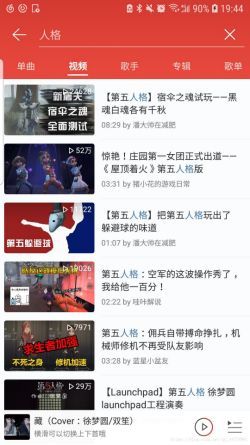第七单元:Fragment+ViewPager+TabLayout
Fragment+ViewPager+TabLayout
- TabLayout的介绍
- Banner 轮播图的使用
- 课后作业
- 技能一
- 技能二
TabLayout的介绍
Tablayout继承自HorizontalScrollView,用作页面切换指示器,因使用简便功能强大而广泛使用在App中。
官方介绍,TabLayout 是一个横向标签显示的布局,效果就是现在很多新闻客户端的那种顶部标签展示效果,并支持指示器、 ViewPager 联动
简单使用
按照惯例,我们先看一下效果图:

从效果图来看,这是采用 TabLayout + ViewPager 滑动切换和点击标签切换的一个效果。TabLayout 支持横向滚动多标签设置,还可以支持指示器,支持与 ViewPager 进行联动。下面看看具体实现
1 ,引入 com.android.support:design
TabLayout 是属于 com.android.support:design 包的控件,所以需要依赖该包
implementation 'com.android.support:design:28.0.0'
2,MainActivity的xml文件的创建
<?xml version="1.0" encoding="utf-8"?>
<LinearLayout xmlns:android="http://schemas.android.com/apk/res/android"
xmlns:app="http://schemas.android.com/apk/res-auto"
xmlns:tools="http://schemas.android.com/tools"
android:layout_width="match_parent"
android:orientation="vertical"
android:layout_height="match_parent"
tools:context=".MainActivity">
<android.support.design.widget.TabLayout
android:id="@+id/tab_id"
app:tabSelectedTextColor="#E5AF35"
app:tabTextColor="#969696"
app:tabIndicatorColor="#E5AF35"
app:tabIndicatorHeight="5dp"
app:tabMode="scrollable"
android:layout_weight="1"
android:layout_width="match_parent"
android:layout_height="0dp">
</android.support.design.widget.TabLayout>
<android.support.v4.view.ViewPager
android:id="@+id/vp_id"
android:layout_weight="8"
android:layout_width="match_parent"
android:layout_height="0dp">
</android.support.v4.view.ViewPager>
</LinearLayout>
从 xml 布局文件看,根布局为一个垂直的线性布局,包含 TabLayout 和 ViewPager。重点看一下 TabLayout 的几个常用属性值
app:tabBackground 标签布局的背景色
app:tabIndicatorColor 指示器的颜色
app:tabIndicatorHeight 指示器的高度(如果不需要指示器可以设置为0dp)
app:tabMode 显示模式:默认 fixed(固定),scrollable(可横向滚动)
app:tabPadding 标签内边距
app:tabSelectedTextColor 标签选中的文本颜色
app:tabTextAppearance 标签文本样式
app:tabTextColor 标签未选中的文本颜色
3,Java代码:MainActivity.java
package com.example.day007;
import android.support.annotation.Nullable;
import android.support.design.widget.TabLayout;
import android.support.v4.app.Fragment;
import android.support.v4.app.FragmentStatePagerAdapter;
import android.support.v4.view.ViewPager;
import android.support.v7.app.AppCompatActivity;
import android.os.Bundle;
import android.view.Window;
import com.example.day007.adapter.MyFragmentAdapter;
import com.example.day007.fragment.OneFragment;
import com.example.day007.fragment.TwoFragment;
import java.util.ArrayList;
import java.util.List;
public class MainActivity extends AppCompatActivity {
private TabLayout tabId;
private ViewPager vpId;
private List<Fragment> list = new ArrayList<>();
private List<String> titles = new ArrayList<>();
@Override
protected void onCreate(Bundle savedInstanceState) {
super.onCreate(savedInstanceState);
supportRequestWindowFeature(Window.FEATURE_NO_TITLE);
setContentView(R.layout.activity_main);
tabId = findViewById(R.id.tab_id);
vpId = findViewById(R.id.vp_id);
list.add(new OneFragment());
list.add(new TwoFragment());
list.add(new OneFragment());
list.add(new TwoFragment());
titles.add("视频");
titles.add("新闻");
titles.add("图片");
titles.add("留言");
MyFragmentAdapter myFragmentAdapter = new MyFragmentAdapter(getSupportFragmentManager(), list, titles);
vpId.setAdapter(myFragmentAdapter);
//把viewPager和tabLayout绑定在一起,注释掉看看效果.
tabId.setupWithViewPager(vpId);
}
}
4,适配器代码:MyFragmentAdapter.java
package com.example.day007.adapter;
import android.support.annotation.Nullable;
import android.support.v4.app.Fragment;
import android.support.v4.app.FragmentManager;
import android.support.v4.app.FragmentPagerAdapter;
import android.support.v4.app.FragmentStatePagerAdapter;
import android.support.v4.view.ViewPager;
import java.util.ArrayList;
import java.util.List;
/**
* ${FENG}
* 2019-07-11
*/
public class MyFragmentAdapter extends FragmentStatePagerAdapter {
private List<Fragment> list;
private List<String> titles;
public MyFragmentAdapter(FragmentManager fm, List<Fragment> list, List<String> titles) {
super(fm);
this.list = list;
this.titles = titles;
}
@Override
public int getCount() {
return list.size();
}
@Override
public Fragment getItem(int i) {
return list.get(i);
}
//返回与viewpage关联以后的tablayot的内容
@Nullable
@Override
public CharSequence getPageTitle(int position) {
return titles.get(position);
}
}
5,Fragment创建一个右键带布局的就搞定,不用其他改变.
/**
* A simple {@link Fragment} subclass.
*/
public class OneFragment extends Fragment {
public OneFragment() {
// Required empty public constructor
}
@Override
public View onCreateView(LayoutInflater inflater, ViewGroup container,
Bundle savedInstanceState) {
// Inflate the layout for this fragment
return inflater.inflate(R.layout.fragment_one, container, false);
}
}
Banner 轮播图的使用
最好的说明,就是官方文档,跟我一起来.
https://github.com/youth5201314/banner
课后作业
技能一
使用Banner做一个轮播图
技能二
1,使用RadioButton+Fragment+ViewPager实现引导页 如图(1)效果 音乐符可以不一样
2,引导页一共四页,当滑动到第四页的时候显示按钮点击跳转到登录界面
3,主页面里面有一个activity和四个fragment+TabLayout 要实现联动.
4,第一个Fragment里有一个按钮,点击按钮发送一条通知
5,切到第二个Fragment弹出Popupwindow。
6,切到第三个Fragment的里面有一个按钮,点击按钮给Fragment1发送一个广播(使用EventBus完成).修改Fragment1的按钮的text值为"发送通知".